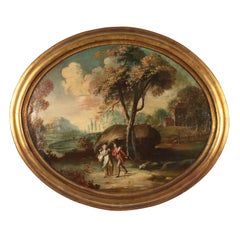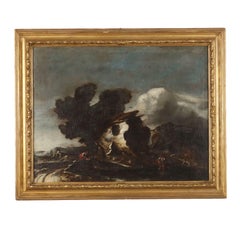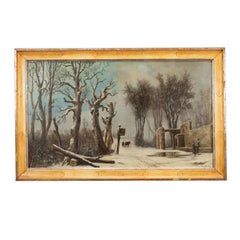Want more images or videos?
Request additional images or videos from the seller
1 of 12
UnknownDipinto Paesaggio con Edifici e Figure, XVIII secolo, olio su tela1700s
1700s
$3,369.37List Price
About the Item
- Creation Year:1700s
- Dimensions:Height: 36.62 in (93 cm)Width: 46.46 in (118 cm)Depth: 1.97 in (5 cm)
- Medium:
- Period:
- Condition:
- Gallery Location:Milan, IT
- Reference Number:1stDibs: LU680312276692
About the Seller
4.8
Vetted Professional Seller
Every seller passes strict standards for authenticity and reliability
Established in 2017
1stDibs seller since 2017
126 sales on 1stDibs
Typical response time: 3 hours
Authenticity Guarantee
In the unlikely event there’s an issue with an item’s authenticity, contact us within 1 year for a full refund. DetailsMoney-Back Guarantee
If your item is not as described, is damaged in transit, or does not arrive, contact us within 7 days for a full refund. Details24-Hour Cancellation
You have a 24-hour grace period in which to reconsider your purchase, with no questions asked.Vetted Professional Sellers
Our world-class sellers must adhere to strict standards for service and quality, maintaining the integrity of our listings.Price-Match Guarantee
If you find that a seller listed the same item for a lower price elsewhere, we’ll match it.Trusted Global Delivery
Our best-in-class carrier network provides specialized shipping options worldwide, including custom delivery.You May Also Like
Ranchlands After the Rain
By Joseph McGurl
Located in Colorado Springs, CO
Original oil painting on linen by artist Joseph McGurl. Framed.
Category
21st Century and Contemporary Photorealist Landscape Paintings
Materials
Oil, Linen
The Cast Shadow
By Joseph McGurl
Located in Colorado Springs, CO
Original oil painting on linen by artist Joseph McGurl. Framed.
Category
21st Century and Contemporary Photorealist Landscape Paintings
Materials
Linen, Oil
Riders Through Time and Space
By Joseph McGurl
Located in Colorado Springs, CO
Original oil painting on linen by artist Joseph McGurl. Framed.
Category
21st Century and Contemporary Photorealist Landscape Paintings
Materials
Linen, Oil
Benavente Solís 15 Landscape - original expressionist
By Benavente Solis
Located in CORAL GABLES - MIAMI, FL
Landscape original expressionist painting. frame
Work of the Spanish artist BENAVENTE SOLIS.
Perfect state .
During its first exhibition in Paris, the French press catalogs it lik...
Category
1990s Expressionist Landscape Paintings
Materials
Wood, Oil
$4,400
Free Shipping
H 36.23 in W 25.6 in D 0.4 in
'End of the Day', Breton Figural Landscape, Brittany Harvest, Style of Millet
Located in Santa Cruz, CA
Late 19th century French School, Unsigned and painted circa 1860. Oil on artist prepared panel. Bearing artist supplier label of 'F.W. Devoe & Co., New York' with 1852 trade mark.
A...
Category
1860s Landscape Paintings
Materials
Oil, Wood Panel
$2,850
H 14 in W 18 in D 0.13 in
London Skyline and Thames at Night - cityscape impressionism - contemporary art
Located in London, Chelsea
This exceptional artwork is currently on display and available for sale at Signet Contemporary Art Gallery and online.
Tushar Sabale’s London Skyline and Thames at Night captures th...
Category
21st Century and Contemporary Impressionist Landscape Paintings
Materials
Canvas, Oil
$1,446
H 17.72 in W 29.53 in D 1.19 in
Summer Shoppers on Regent Street - cityscape impressionism - contemporary art
Located in London, Chelsea
This exceptional artwork is currently on display and available for sale at Signet Contemporary Art Gallery and online.
In Summer Shoppers on Regent Street, Tushar Sabale distills th...
Category
21st Century and Contemporary Impressionist Landscape Paintings
Materials
Canvas, Oil
$5,235
Free Shipping
H 25.99 in W 35.83 in D 1.19 in
Green Composition - Oil Paint by Edolo Masci - 1990s
Located in Roma, IT
Oil on canvas realized by Edolo Masci in 1990s.
Hand signed.
Very good condition.
Edolo Masci was born in Castiglione a Casauria in 1938 and moved to Rome at a young age, where he...
Category
1990s Contemporary Figurative Paintings
Materials
Canvas, Oil
$481
H 11.82 in W 23.63 in D 0.4 in
Diamonds in Bloom - Original floral realism painting - modern surrealistic art
Located in London, Chelsea
This exceptional artwork is currently on display and available for sale at Signet Contemporary Art Gallery and online.
Mysterious and radiant, Diamonds in Bloom reveals Hallie Packa...
Category
21st Century and Contemporary Surrealist Landscape Paintings
Materials
Canvas, Oil
$4,119
Free Shipping
H 24.02 in W 18.12 in D 1.19 in
'Steam Locomotive at Bry-Sur-Marne', Paris, Salon des Artistes Français, Benezit
Located in Santa Cruz, CA
Signed lower right, 'A. Delauzieres' for André Delauzieres (French, 1904-1941), dated 1936 and titled 'Bry-Sur-Marne'.
Provenance: Collection of Ole Wulff, Denmark.
A substantial,...
Category
1930s Landscape Paintings
Materials
Canvas, Oil
$6,500
H 23.75 in W 36.25 in D 0.75 in
More From This Seller
View AllWoodland Landscape with Figures 1883
Located in Milan, IT
Oil on Canvas. Signed and dated bottom right.
The landscape sees a stream flowing within a shady coniferous forest; two young boys try their hand at fishing, using rural tools. The a...
Category
19th Century Other Art Style Landscape Paintings
Materials
Oil
Oval painting Landscape with Figures late 1800s early 1900s
Located in Milan, IT
Oil on canvas, applied to faesite in the second half of the 1900s.
The painting echoes 18th-century pictorial modes with a decorative slant.
In a tranquil landscape, with architectur...
Category
Late 19th Century Other Art Style Landscape Paintings
Materials
Oil
Dipinto Paesaggio con Edificio e Figure XVIII secolo
Located in Milan, IT
Olio su tela. Scuola genovese del XVIII secolo.
Il paesaggio di campagna vede ergersi al centro una struttura fatiscente, i ruderi di un edificio attraverso le cui pareti squarciate ...
Category
18th Century Other Art Style Landscape Paintings
Materials
Oil
Snowy Landscape with Figures, 1872
Located in Milan, IT
Oil painting on canvas. Signed, dated 1872 and located in Parma in the lower right corner. It is a large winter landscape with a strong scenic i...
Category
19th Century Landscape Paintings
Materials
Oil
$23,585 Sale Price
20% Off
Landscape with the penitent St. Jerome, XVIIth - XVIIIth century
Located in Milan, IT
Oil painting on canvas. Northern Italian school of the 17th-18th century. In a large, rather barren hilly landscape, which widens and fades to the right, there is a high rock, shaped...
Category
Late 17th Century Other Art Style Landscape Paintings
Materials
Oil
$5,872 Sale Price
20% Off
Landscape painting with figures, XVIIIth century
Located in Milan, IT
Oil painting on canvas. Central European school of the eighteenth century. Under a blue sky, a large, rather barren landscape is depicted, with the edge of a wood opening onto a rock...
Category
18th Century Other Art Style Landscape Paintings
Materials
Oil
$3,224 Sale Price
20% Off
Recently Viewed
View AllMore Ways To Browse
Oil Paintings Of Venice
Painting English Countryside
Painting Trolley
Skyscapes Art
Thames Painting
Winter Scene Paintings
1975 Oil Painting
American Farm Art
Gordon Oil Painting
Impressionist Sailboat Paintings
Royal Marines
Best Sellers
French Painting Horse And Carriage
Impressionist Poppies
Landscape Oil Painting Market
Metal Frame Oil Paintings
New Hope School
19th Century Flemish Oil Painting


